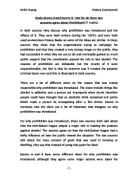Abbas Tejani
Prohibition coursework question (a)
Study sources A and B
How far do these sources agree about prohibition? (7 marks)
Both sources, A and B agree on the fact that 1917 was a very significant year when it came to prohibition. Source A says that ‘By 1917, twenty-three states had already introduced a ban on alcohol’. Source B also says that 1917 was significant because: ‘In 1917 a nation-wide campaign, led by the Anti-Saloon league, brought pressure on the congress to ban the use of grain for either distilling or brewing’. Both sources also stress the importance of the Anti-Saloon league. Source A says ‘…the influence of the Anti-saloon league at a time when large number of men were absent from the armed forces’. Source B says ‘…a nation-wide movement, led by the Anti-saloon league’. This was a campaign led by people who were moral protesters to alcohol and believed that it was an evil in society. Both sources actually mention that alcohol and the saloons they were served in were seen as an evil in society. Source A says ‘…bad influence of saloons’ and source B says ‘…one of the great evils of the time – alcohol.’
However, Source A gives a variety of possibilities as to why prohibition was introduced and Source B speaks more about the groups who were against the introduction of prohibition and what their reasons were. Source A gives a variety of reasons. All the reasons though, are in the context of the war. It describes the First World War in 1917, as the reason for the introduction of prohibition. The war caused a lot of Anti-German feeling in America. Source A says ‘…the wartime concerns for preserving grain for food, feelings against German-Americans who were important in brewing and distilling’. It also mentions the ‘army’, which is also tied into the idea of war. The quote shows that the war played an important role in the introduction of prohibition. The Germans were also hated as a result of the war, which adds greater weight to this statement. Source B lists the groups that were campaigning for the introduction of prohibition. Many people found it hard to argue with these groups as they had a moral reason for campaigning – alcohol was seen as an evil in society. Anyone who argued against them would be seen as obstructing a good cause. The source also says ‘Most important of all the moral fervour inspired by the war’. Source B concentrates more on groups such as the ‘Women’s Christian Temperance movement’ and the ‘Anti-saloon league’, which both put pressure on the government to introduce a ban against prohibition, however there were marked differences on what they saw as key characteristics. Both sources mention that each group thought that drink brought ruin and debauchery.







